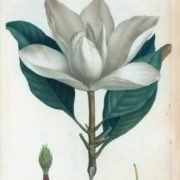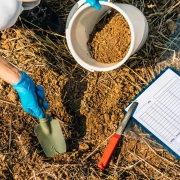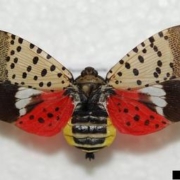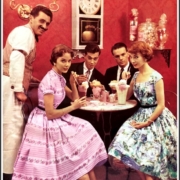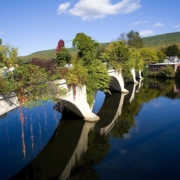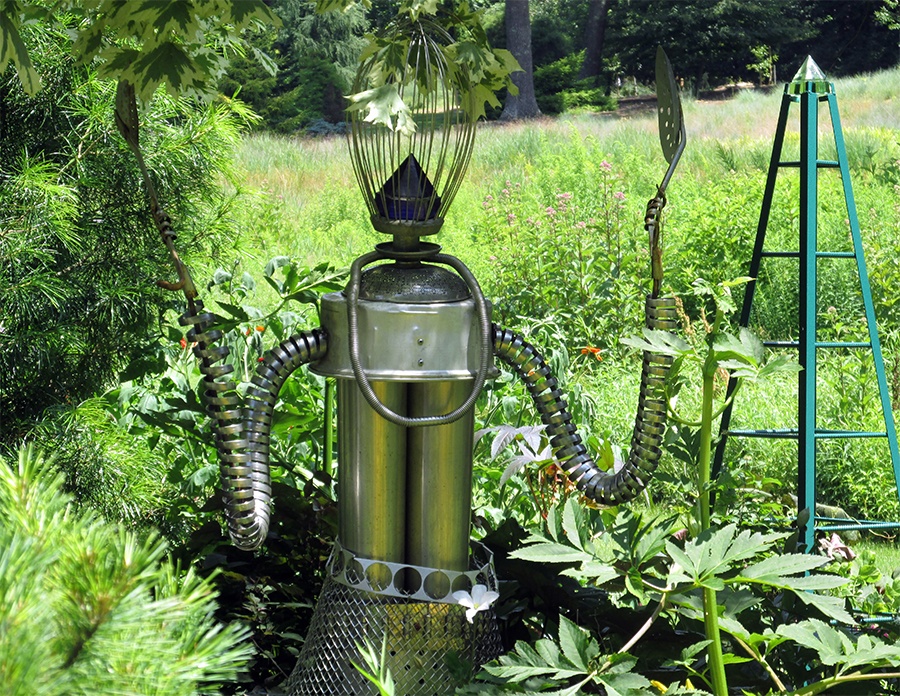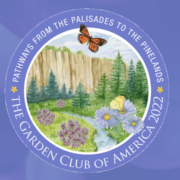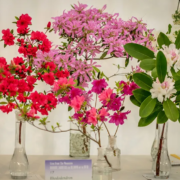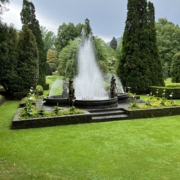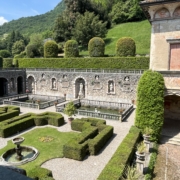How to Test Your Garden Soil (10-24-2022)
Soil testing gives you a snapshot of the health and fertility of your garden soil. It takes the guesswork out of how much fertilizer and water to use. It also tells you if you have a deficiency in a micro or macro nutrient, and how alkaline or acidic your soil is. The test results will help you amend your soil for better plant growth.
You can bring soil samples to the Dec 1, 2022 Horticulture Committee meeting at Ellen Gould’s home and Nan and Sherry will hand deliver your sample(s) to the CT Agricultural Experimental Station (CAES) in New Haven. There is no cost, and you will receive results by mail.
Here are the steps to get a good soil sample:
- Dig several thin slices of soil with a shovel or trowel in the area you want to be tested (4-6” deep in the garden and 3-5” deep in lawns). Combine the slices in a bucket and mix thoroughly.
- Do not combine samples from different areas if soil, fertilizer treatments or lime additions are different. Sample each area separately.
- Place 2 cups of mixed soil in a ziplock bag. If the soil is wet, let it dry before sealing the bag.
- Seal the bag and apply a label to the outside with the following information:
- Your name and mailing address
- The plants you are growing, or want to grow in the sampled area.
- Any plant problems that have occurred.
- State if you would like organic care instructions.
Questions? For more information on how to test your soil, read the CAES Soil Testing Brochure HERE.
Recently, the Spotted Lanterfly was seen on a tree outside of Pequot Library in Southport. If you see one, kill it! Read more below from UCONN.
Spotted Lanternfly on the Move in Connecticut
Help Maintain the Spread of the Spotted Lanternfly in Connecticut
The Spotted Lanternfly (SLF) is continuing its move through Connecticut. It has been found in Orange and Milford, Connecticut. It is important that everyone help spread the word about this invasive pest. Many farms in Connecticut have visitors that travel from areas where SLF populations are established in Connecticut and outside Connecticut.
What can you do if you see an SLF?
All Residents:
Agricultural Producers:
There are 2 posters from USDA APHIS you can download and post at your farm stands, farm markets and pick–your–own locations to alert the general public. If they understand this pest has the potential to have a negative impact on their favorite farm – your place – they may be more inclined to take an active role in slowing down the movement of SLF. And for every adult female they destroy, there will be roughly 90 less SLF the next year.
https://news.extension.uconn.edu/tag/spotted-lanternfly/#
From Dan Woog’s 06880 Blog
I have only a vague recollection of The Separate Shop. That’s okay — I was not the women’s clothing store’s target audience. Plus, it opened before I was born, and was in my early teens when it was sold.
I have better memories of The Ice Cream Parlor — a teeny bit in its first location (most recently, by Tavern on Main), much better after it moved to Post Road East (next to Colonial Green, opposite Salsa Fresca).
 The Ice Cream Parlor, on the Post Road
The Ice Cream Parlor, on the Post RoadBut those memories pale compared to Butzi Moffitt’s. She owned them both.
And at 94, she talks about them as if those 1950s and ’60s days were yesterday.
Butzi’s Southport home is filled with photos. (And — in the kitchen — an actual wrought-iron Ice Cream Parlor table.)
Those photos include Butzi with Marilyn Monroe. She was great friends with Milton Greene, the Weston photographer who helped make the actress famous.
“She was sweet, caring, gentle,” Butzi recalls. “Not a tough cookie at all.”
 Marilyn Monroe (right) and Butzi Moffett (left), at a New York party.
Marilyn Monroe (right) and Butzi Moffett (left), at a New York party.Butzi became a store owner in 1952. She worked for a woman who owned an “unsuccessful” dress shop.
“I thought women’s sportswear would be more popular,” Butzi says. The Separate Shop opened in Sconset Square — then called Sherwood Square — and soon there were “lines out the door.”
At Christmas, customers filled out “want books.” They told their husbands just to go to The Separate Shop; Butzi and her staff would pick out what the wives wanted.
The store delivered too — via horse — within a 1 1/2-mile radius.
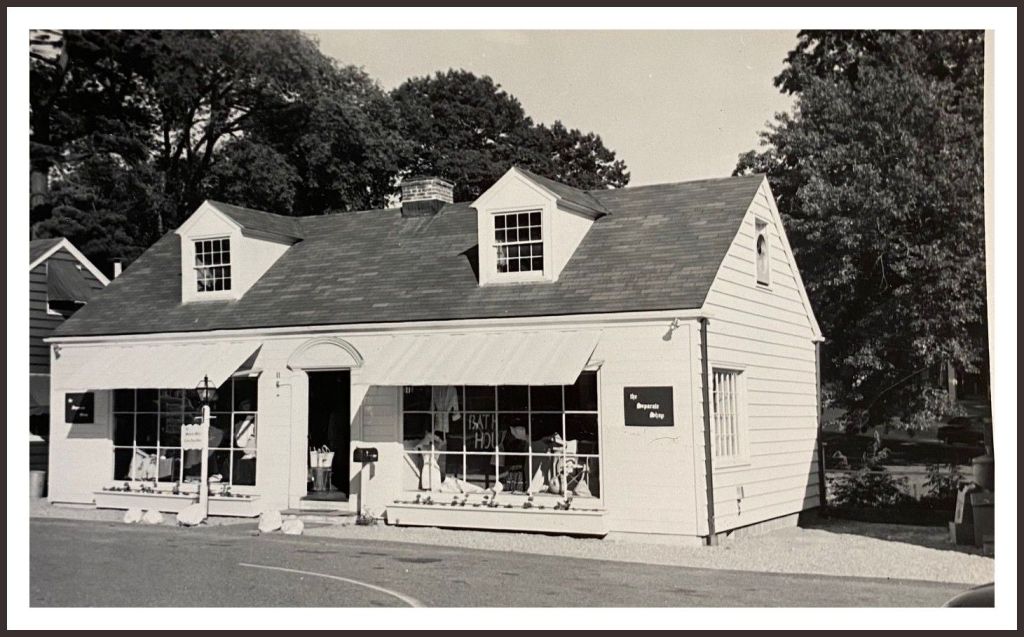 The Separate Shop, in Sherwood (not Sconset) Square
The Separate Shop, in Sherwood (not Sconset) SquareThe store’s name comes from her plan to sell items — skirts, blouses, etc. — “separately.” She had always found it difficult, as a “short-waisted woman,” to buy a one-piece dress without alterations. She realized that a wardrobe of separates could solve problems of those who were “too tall and long-waisted, the top-heavy, the large hipped, the too round and too thin,” a Westport Town Crier story said.
It added: “One of the first of the so-called ‘country stores’ to combine high style with more conventional items, the Separate Shop is often referred to in the garment business as ‘the grandmother of the trade.'”
An undated story in a retailing magazine noted, “The Sepaarate Shop now does $200,000 woth of business a year and has achieved etailing fame as a major launching point for such now-established items as Shetland sweaters, Bermuda shorts, car coats and, more recently, the long ‘at home’ dinner skirt.”
Marilyn Monroe was a regular customer, Butzi says. She bought cashmere sweaters in 3 sizes — 32, 24 and 36 — to wear in different seasons.
The Ice Cream Parlor opened in 1953. She and her then-husband, Robert Beach, could not find good old-fashioned ice cream around here.
They learned of a country store going out of business in Saratoga Springs, New York. The bought what they needed, and brought it to Westport.
The concept was “nostalgia” — in the 1950s, for an earlier time. The old-fashioned ice cream parlor featured a marble soda fountain, wire-backed chairs, nickelodeon, penny candy and syrup in wax bottles.
 Outside the Ice Cream Parlor…
Outside the Ice Cream Parlor…It boasted that its “ice cream concoctions” were part of “the pomp and splendor, the gaudy, gay and garulous [sic] of an era past and a child’s wildest dreams come true.”
It was an instant hit, Butzi says.
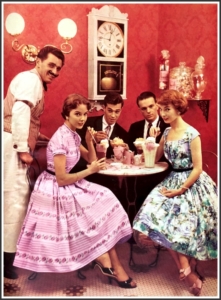 …and inside. (This is from a 1955 Seventeen magazine photo shoot.)
…and inside. (This is from a 1955 Seventeen magazine photo shoot.)
The Separate Shop and Ice Cream Parlor were not Butzi’s only successes. She owned the Pack Roads men’s store, opposite Remarkable Book Shop at the Main Street entrance to Parker Harding Plaza (near where the Separate Shop relocated in the 1960s).
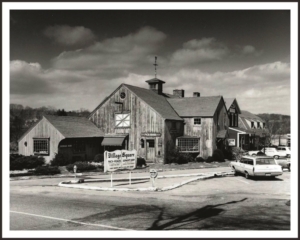
Butzi also helped design costumes, and the scrim, for the Westport Country Playhouse.
She owned an apartment one block from the Metropolitan Museum of Art, and spent 50 years as a docent.
Butzi married Peter Moffitt in 1962. She sold the Separate Shop 2 years later, when their twins were born.
Noting the closing, the Town Crier wrote: “While wishing the new owners of the Separate Shop all sorts of luck and Butsy [sic] Moffitt a happy retirement, we have a sneaking suspicion that her boundless energy will probably take her out of the house and back into the business world before long.”
Nearly 60 years later, the Separate Shop, Pack Roads and Ice Cream Parlor are part of Westport’s long-ago past.
Less than 6 years away from her 100th birthday, meanwhile, Butzi Moffitt, still has plenty of energy.
And many, many memories.
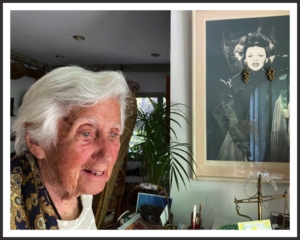
Butzi Moffett in her Southport home. She put the earrings on the portrait of Judy Garland. (Photo/
Hat tip: Jeanne Reed
Tasteful Flowers
It’s a humbling reminder that eating flowers is nothing new. The bees have known all along how good flowers can be. Now it’s our turn
“We might think we are nurturing our garden, but of course it is our garden nurturing us.”
Welcome to the Art of Growing Food newsletter. I’m Ellen Ecker Ogden author of The New Heirloom Garden and five other books featuring kitchen garden designs with recipes for cooks who love to garden. Every week, you’ll find artful growing tips and ideas for fresh eating from your kitchen garden, to make your own garden a sanctuary for outdoor living.

Hello Everyone.
Borage is blooming in my garden right now. It is a rambling plant, with expansive hairy leaves and a sprawling habit. The foliage makes a calming tisane with a slight cucumber flavor, yet I prefer to harvest the tiny iridescent blue star-shaped flowers to garnish a chilled Gazpacho soup. Capturing these delicate beauties to adorn salads, or jazz up a dinner plate is the easiest way of bringing the garden to the table.
Flowers add eye appeal and enhance sensory qualities in ways you may not even notice. Edible flowers are everywhere, in our gardens, and in the wild. The best way to get to know which edible flowers to use is to taste the petals because not all flowers taste good. Some are herbal and honey filled while others can be peppery.
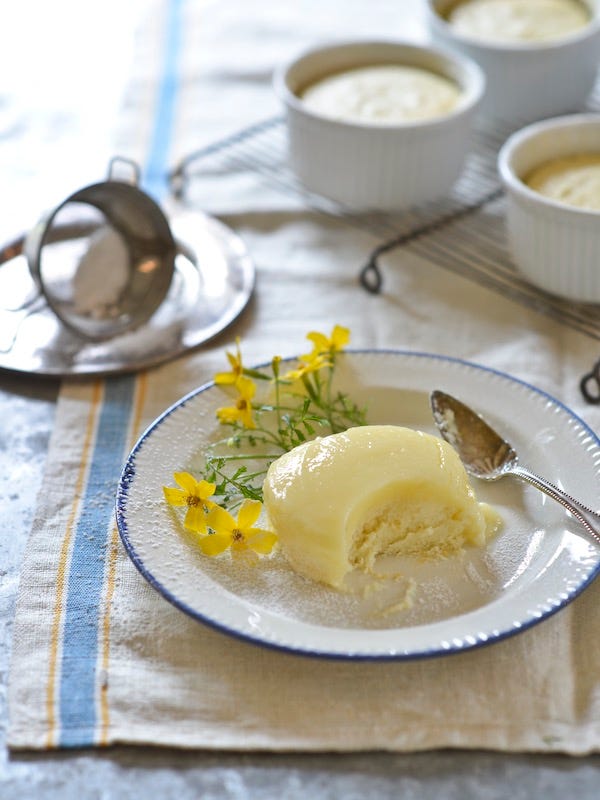
Taste, Color, and Fragrance
Flowers and vegetables are equal partners in my kitchen garden because they work in tandem with each other. The flowers attract pollinators, which give the crops a boost. From years of growing and tasting different varieties, I’ve developed a few favorites which include the most familiar of edible flower: nasturtiums. I’ve grown over 25 different types of nasturtiums from blazing red with peppery hot colors and spicy flavor, to gentle pale yellow blossoms known as Moonlight.
The truth is that each nasturtium will taste a little different. My favorite is an old heirloom variety called Phoenix, with frilly leaves and a vining habit that stretches over the boxwood in the front of the house border.
My original seeds were bought from Select Seeds, yet now I save my own seeds from year to year by allowing the blossoms to form into brown seed pods at the end of their growing season. Oftentimes, I allow them to self-sow, spreading around volunteer plants through the kitchen garden the following spring.

This time of year, when the planters are spilling over, why not make nasturtium butter by combining a stick of room temperature butter with two dozen nasturtium flowers, a handful of nasturtium leaves, and a clove of garlic or some chives. Combine the herbs and blend them into the butter, and it is ready to serve or freeze for later use over lightly sautéed vegetables.
Sweet herbal flowers such as anise hyssop, lavender, or beebalm add a cheerful sprig to garnish a fruit dessert or churned it into a floral-tasting sorbet. Separate the petals from the blossom heads for roses, calendula, and chives to decorate a composed salad, while pansies, runner beans, and arugula blossoms are delicate enough to be eaten whole.

For special occasions, I will make the classic Italian dish of stuffed zucchini flowers, blending together ricotta cheese, onions, and toasted almonds or pine nuts with grated Parmesan cheese. Season with salt and fresh basil, and once the blossoms are filled, tie the ends with a chive. Either fry in hot oil or drizzle with melted butter and bake at 350*degrees for 15 minutes.
Safe to Eat
If you are new to the world of edible flowers, check to see if they are safe to eat. A reliable list such as Edible Wild Plants: A North American Field Guide or the comprehensive database at Plants for a Future (www.pfaf.org) includes information on common and Latin names, keywords, family, habitat, and use (medicinal, edible, or other). Do not eat flowers from a florist shop, since most have been laced with pesticides and preservatives.
With more than a dozen edible flower varieties growing in my kitchen garden, borage is still one of my favorites. It’s a good sign that the bees love it, and there is something totally captivating about the brilliant blue blossoms to garnish a corn and cucumber salad or freeze into an ice cube for a summer drink. It’s a humbling reminder that eating flowers is nothing new. The bees have known all along how good flowers can be, now it’s our turn.
From my kitchen garden,
Ellen O.
Ellen Ecker Ogden
Hat tip: Claire Van de Berghe
Three Road Trips to See Amazing Public Sculpture Gardens across New England
From a topiary garden to a Dr. Seuss park and more.
From day trips to weekend getaways, our biweekly Traveler newsletter shows you the best of New England and beyond.
Claude Monet had his water lilies. Georgia O’Keeffe couldn’t quit the deserts of New Mexico. And here in New England, our mountains, woodlands, meadows, and beaches have dazzled generations of artists. But sometimes, the landscape itself serves as the gallery for New England artwork. From the Connecticut Coast to the Appalachian Mountains, sculpture gardens and outdoor art collections are among New England’s most illustrious recreational offerings. Why not pay a visit to these rustling realms that have inspired and hosted centuries worth of art? These regional road trips will take you to some of the most enchanting outdoor art galleries in our neck of the woods.
Trip #1: Boston to Williamstown, Stockbridge, and Springfield MA (317 miles)
Take Route 2 for a more scenic drive into the hills and valleys of Western Mass. Stop for sandwiches and salads from Shelburne Falls Coffee Roasters in Shelburne Falls and take your lunch to the Bridge of Flowers, where gardeners turn seasonal blooms into a colorful work of art along an old trolley bridge over the Deerfield River.
Climb into the Berkshires via the hairpin turns of the “Mohawk Trail” byway and drive west to the Clark Art Institute. Nestled in the verdant hills of Williamstown, the Clark boasts a hefty collection of European and American paintings, prints, and decorative art. But just as impressive are the institute’s woods. Gentle trails will take you to permanent and rotating sculpture installations on the Clark grounds like Thomas Schütte’s alien-esque Crystal structure before bringing you back to the beautiful reflecting pool in the museum’s courtyard. Come sundown, drop your bags at the Williams Inn, where The Barn offers a tempting gastropub menu with standouts like vegetable-laden kombu dashi ramen and plenty of seasonal libations.
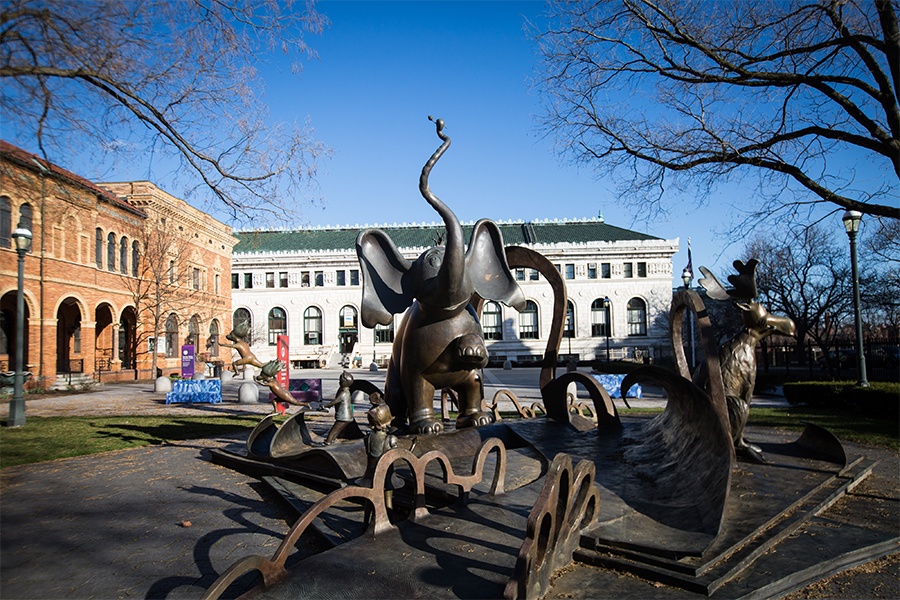
Photo by Keith Bedford/The Boston Globe via Getty Images
The next morning, drive south on Route 7 along the Berkshires’ spine to Stockbridge and tuck into a Greek omelet at the Main Street Cafe before exploring Chesterwood. The lush estate of the late American sculptor Daniel Chester French spans 122 acres and features paths through perennial gardens with sculptures, reliefs, fountains, and decorative benches designed by French. Be sure to leave time for a stop in Springfield for peppery burnt ends at Theodore’s and a more contemporary display of outdoor art—the Dr. Seuss National Memorial Sculpture Garden, where you can behold a life-sized Lorax and reflect on the power of the natural world.
Trip #2: Boston to Lee, Cornish, and Brookline, NH (333 miles)
Set the GPS for New Hampshire, but instead of taking the I-93 straight-shot to Concord, head for the sleepy seacoast village of Lee—hometown of Robert Eggers, director of The Northman and The Witch—and step into Bedrock Gardens, where eerie sculpted figures made of metal and scrap materials inhabit the pines of the aptly-named “Dark Woods.” This gothy little sculpture garden is a neat tribute to New Hampshire’s literary and cinematic history as a setting for woodland horror.
Leave the haunting forest behind by heading northwest toward Concord, swing by Col’s Kitchen for a lunch of nourishing plant-based fare like chana masala, and continue on I-89 North to the Connecticut River as it runs along the Vermont-NH border. Here, in the hills of Cornish, you’ll find Saint-Gaudens National Historical Park, the estate of the Civil War-era sculptor Augustus Saint-Gaudens (he crafted Boston Common’s Shaw memorial featuring the all-black 54th Regiment of Mass.) The sun-splashed lawns and preserved studios of the estate feature some of Saint-Gaudens’ most prized bronze and marble sculptures, posed against a killer view of nearby Mount Ascutney, and the adjacent woods contain a charming path into the ravine where Saint-Gaudens used to swim in a pool beneath several cascades.
As the magic hour paints the landscape in gold, backtrack to the New London Inn, grab a cozy room, and enjoy savory pub fare, frothy craft ales, and sundown mountain views at The Flying Goose. You’ll want extra fuel for the next morning, when you’ll grab coffee and pastries from Blue Loon Bakery before heading south through the woods of the Merrimack Valley and wandering the trails of the Andres Institute of Art, where nearly 100 sculptures are staged around the mossy woods of Big Bear Mountain, which founder Paul Andres purchased in 1996.
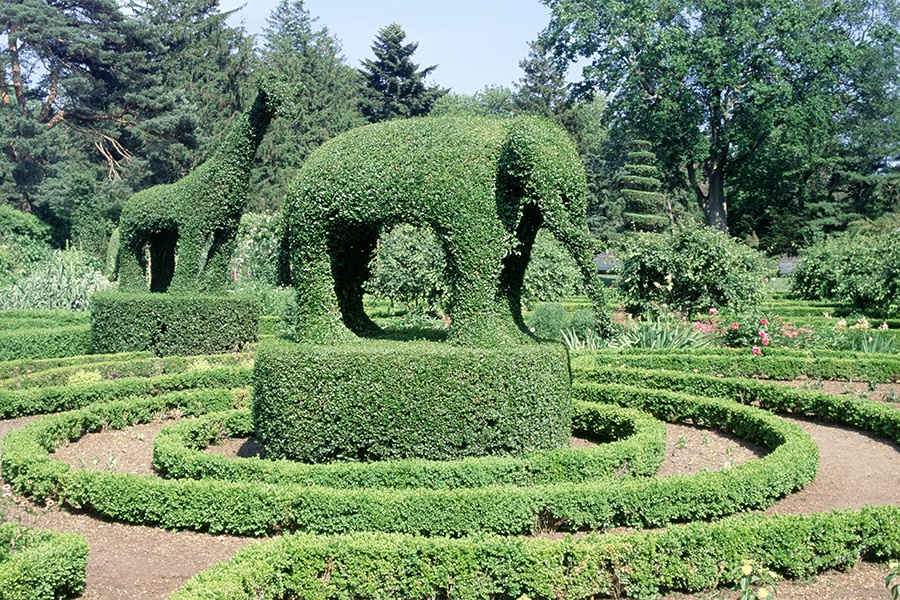
Photo by Barry Winiker/Getty Images
Trip #3: Boston to Coventry and Old Lyme, CT and Portsmouth, RI (272 miles)
Cross into Connecticut on I-84 South, but leave the New York crowd behind and drive south into the hills and farmlands of Tolland County for a serene stroll amid the David Hayes Sculpture Fields. Named for the Hartford-born sculptor whose colorful works of welded steel works have appeared in galleries at the Guggenheim and MoMA, the sculpture fields are essentially pastures for Hayes’ creations, which now preside over hayfields, a pond, and an old orchard that are open to the public for wandering.

Word Tree at Studio 80 photo by Christina Goldberg
From here, things escalate as you drive south and detect the briny sea breeze of Connecticut’s beaches and coastline. Veer west for Old Lyme, refuel with hearty focaccia sandwiches or pastas at Sapore Pizzeria Italiana, and once you’ve savored the last morsels, enter the leafy expanse of Studio 80 + Sculpture Grounds, where 66 contemporary artworks by Gilbert Boro and a rotating roster of visiting artists are installed in courtyards and gardens along the Lieutenant River. As dusk begins, stick to the water with an eastward drive along the coast to Mystic for a dinner of maritime morsels at S&P Oyster Restaurant and Bar, and fall asleep to the sound of lapping water at the Steamboat Inn, located right on the Mystic River.
The return journey to Boston begins with a Westerly, Rhode Island pullover at Christina’s Place for decadent diner fare like Belgian waffles with strawberries and whipped cream. But rather than staying on I-95, cross the Claiborne Pell Bridge to Newport and experience a living form of outdoor artwork at the Green Animals Topiary Garden, where around 80 king-size creatures have been clipped and manicured for your gawking pleasure.
Hat tip: Virginia Dean
Behind the Scenes at the Flower Show

Why and How to Enter a Flower Show Class
1.Entering in horticulture classes expands your knowledge of growing your own beautiful plants to enjoy for years. Making your own floral design at home becomes so much easier and more enjoyable
- First time going to a show, go with fellow member. See the early moments of how a show is created the day of. You see the other plants being brought in for horticulture, you will want to try to grow something like that at home. You can grow plants in your home, you just have to find what plants like the environment you can provide for it. One “ordinary” plant grown well can be magnificent.
- You support a club flower show which that club greatly appreciates.
In turn, they will support our show.
In turn, educates the public who come to see the show
How To Enter A Horticulture Class
The Guidelines:
Grooming
No disease, insects, spray residue
Good shape– remove old blooms, dead or yellow leaves, imperfect foliage. Try to create symmetry. Remember brown magic marker tip to cover white wood cuts. Remove all unattractive foliage- people do not know how many leaves your plant originally had.
Pot
Clay, not plastic
Size, appropriate to plant
Clean (mineral oil tip)
Top dressing – Use peat moss, sheet moss (bulbs), very dark soil (Fafards), orchid bark, sand or pebble for cacti, succulents and alpines
Details
Nomenclature, Latin and common name
Download entry card, fill it out before you go to the show
Key card, if required, recheck details of requirements
Transporting exhibits to show location: wedge pots with cinder blocks, sand bags, newspaper, cardboard boxes, seat belts are good for large pots
MOST IMPORTANT ADVICE: READ THE SCHEDULE
SECOND MOST IMPORTANT ADVICE: FIND OUT HOW LONG YOU NEED TO OWN YOUR PLANT MATERIAL?
SPECIFIC CLASSES (Typical for most shows):
Par Class
- MUST HAVE OWNED THE PLANT FOR AT LEAST SIX MONTHS
- Judged against perfection of particular plant
- Must be above average
- Length of ownership is an important consideration (eight years versus seven months)
- Make sure your specimen does not fit in any other class (the reason why there is a par class)
Bulb Class
- Blooms all around and if possible, facing forward (with narcissus)
- Flowers should be of equal height, foliage of good color, clean, free of dirt and defect (you can use manicure scissors to cut out imperfections)
- Staking is usually required, but un-staked bulbs will be given extra consideration by the judges
- When planting your pot, jam as many bulbs in as possible
Cut Specimens
- Cut exhibit as late as possible, unless the particular plant material needs to be specially conditioned to last
- Never have foliage submerged in water when exhibiting
- Wedge bottle with cotton, moss, boxwood, or saran wrap so that the specimen stands straight in the container
- If you are not sure if flower is to be exhibited with foliage, cut with foliage
Standards in Topiary Class
- Stakes are allowed if necessary, but un-staked is preferred
- Make sure standard is in the exact center of the pot
BOOK SOURCES:
Hamel, Esther Veramae, The Encyclopedia of Judging and Exhibiting
Flower Show and Judging Guide, Download from The Garden Club of America website
SUGGESTED TOOLS TO BRING TO PASSING FOR EXHIBITING:
Plant mister, paint brushes, brown and black magic marker, scissors, manicure scissors, ruler or measuring tape
Entry Card Information
What does a Latin name mean?
A botanical name must have at least two words. Both genus and species are always italicized.
- It must always have the first, the genus: Ex. Forsythia viridissima
It may include any of the following:
- Species only: Forsythia viridissima
- Species and variety: Forsythia viridissima var. koreana
- Species and cultivar: Forsythia viridissima ‘Bronxensis’
- Cultivar only: Forsythia ‘Beatrix Farand’
The second name or specific epithet of the botanical name, in Latin, is generally accepted in lower case although Hortus Third capitalizes it if it is named for a person.
When the second name is not known, it is permissible to write sp. (species)
Subdivision of Species
Varieties are found in nature
Cultivar is a plant which has been selected and cultivated by man. May be either a hybrid or a variant arising in cultivation. It is always capitalized and in single quotes.

